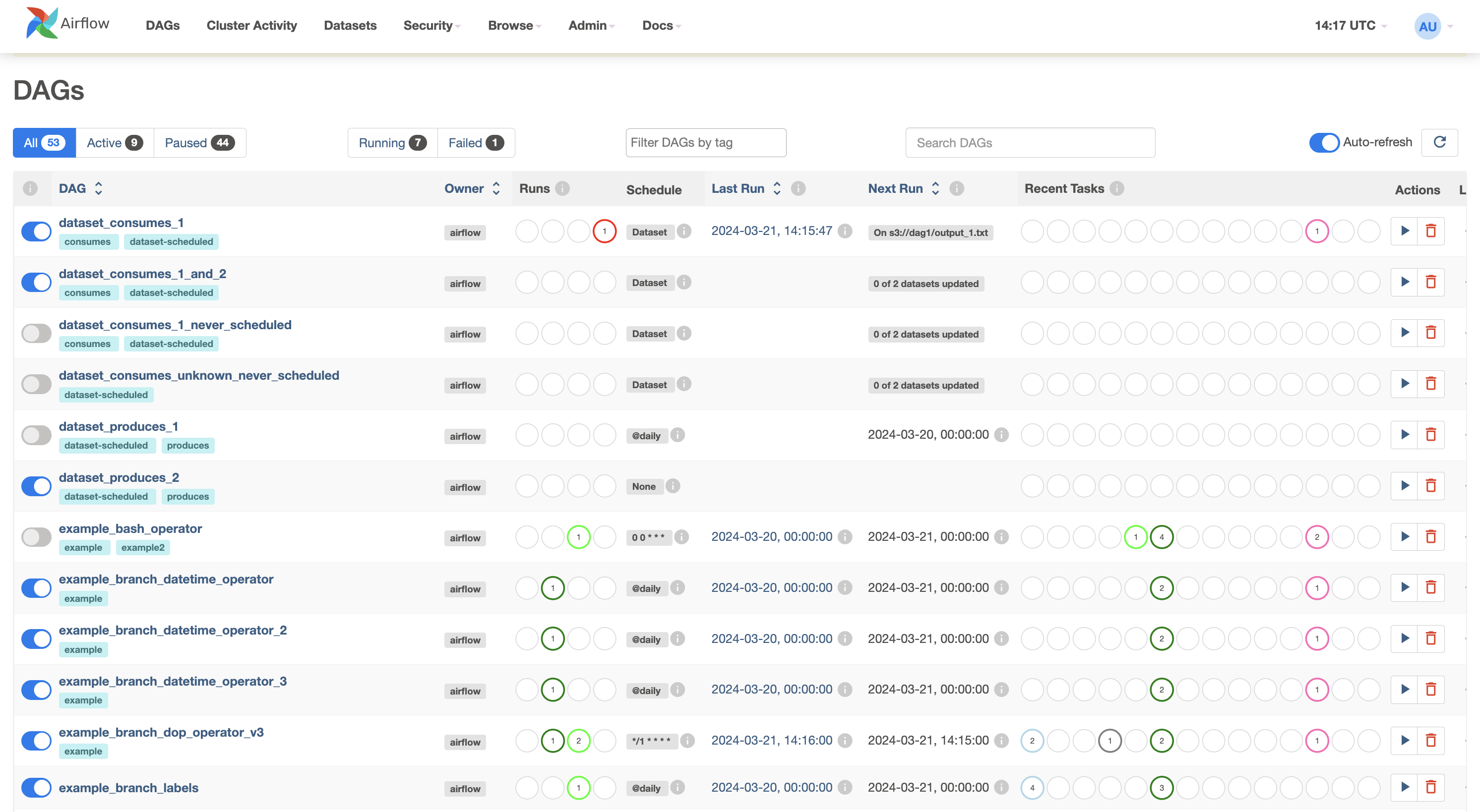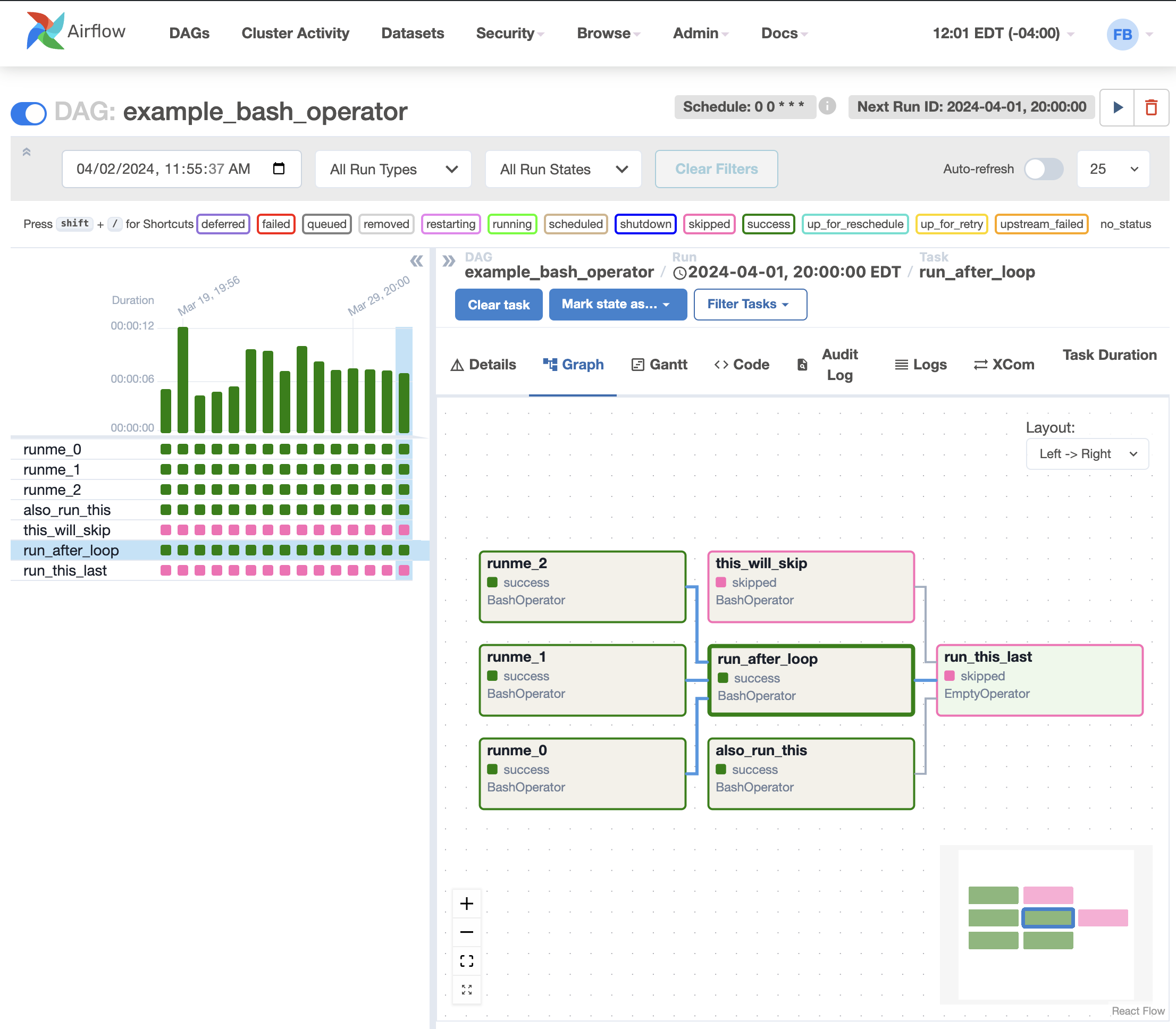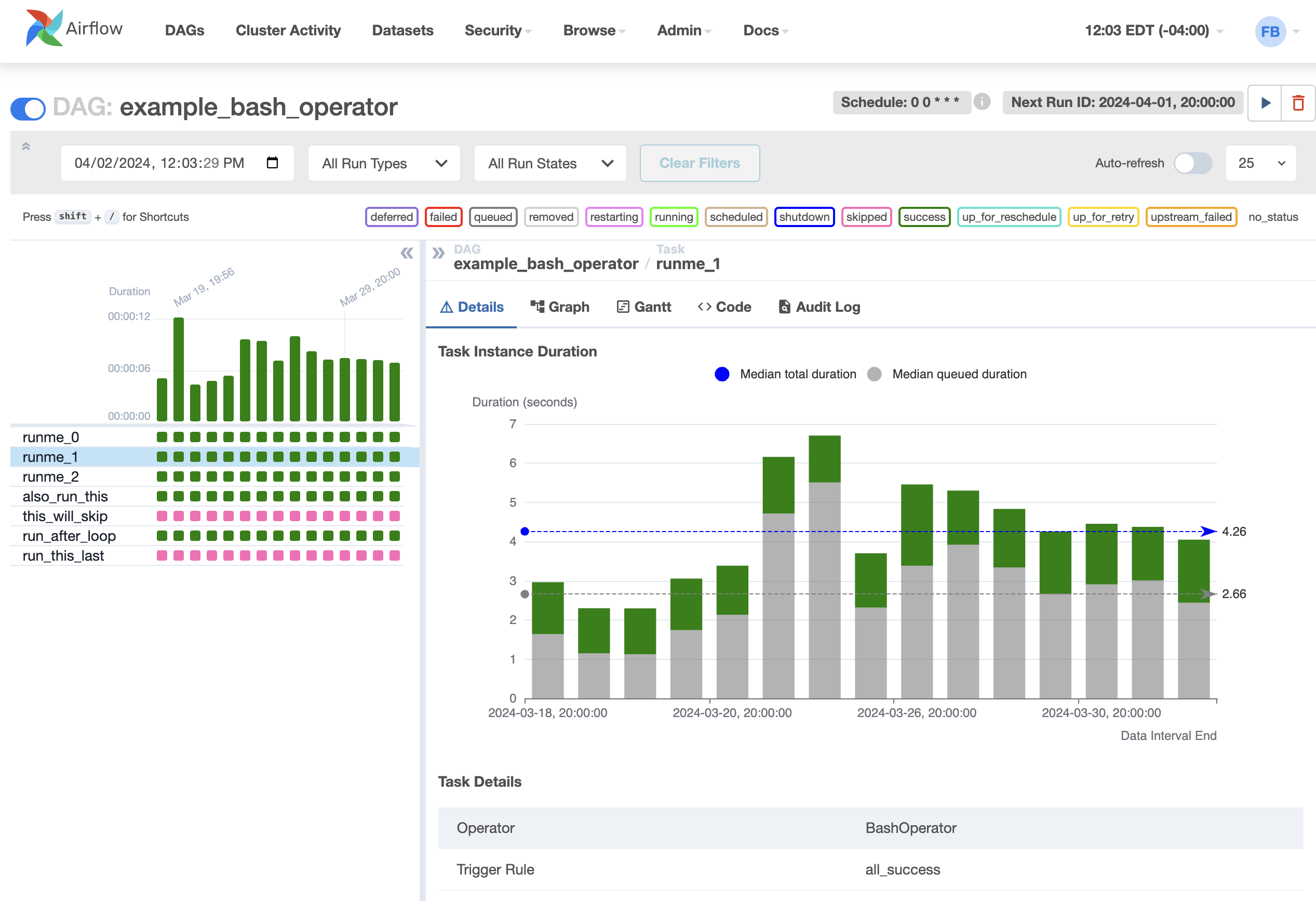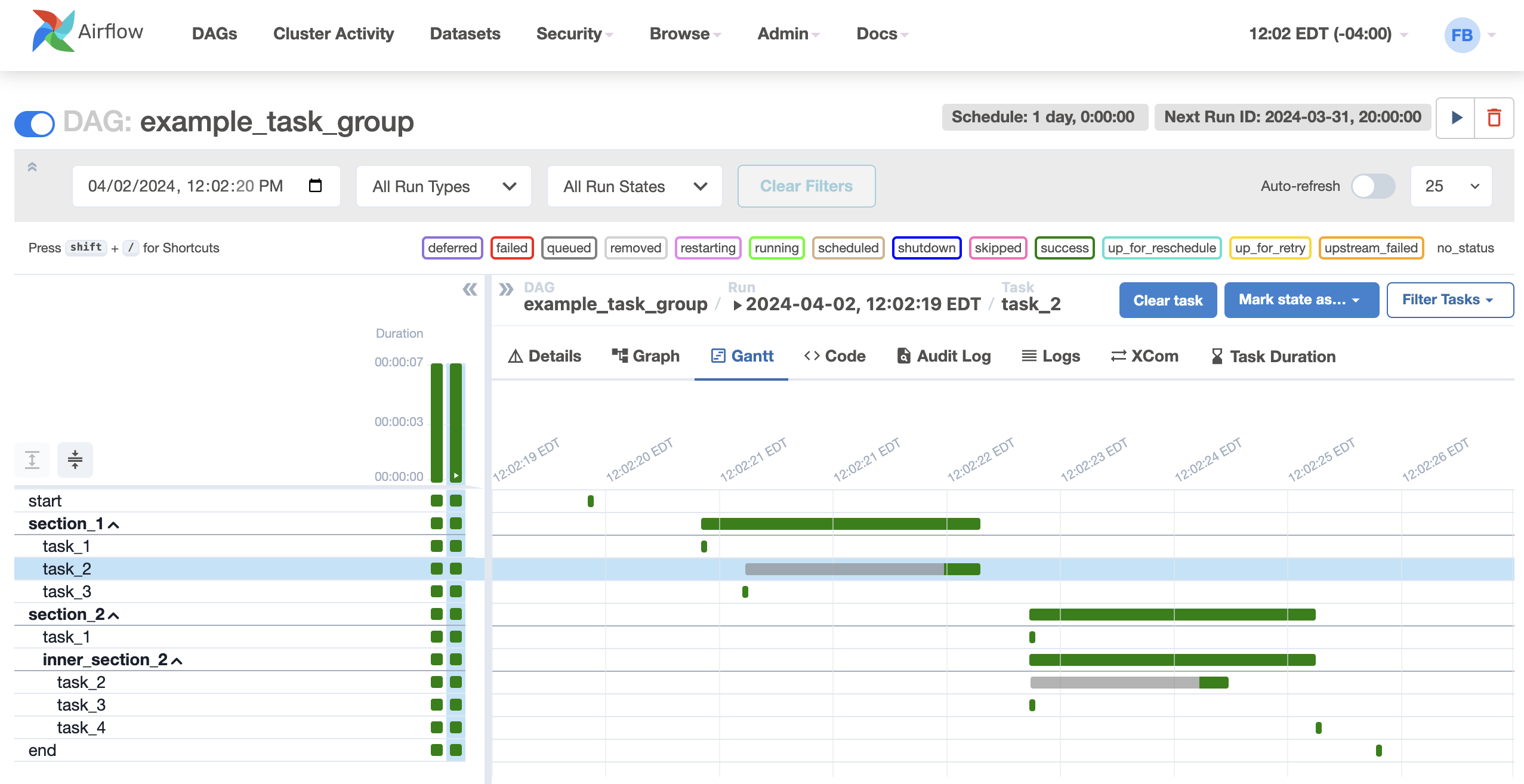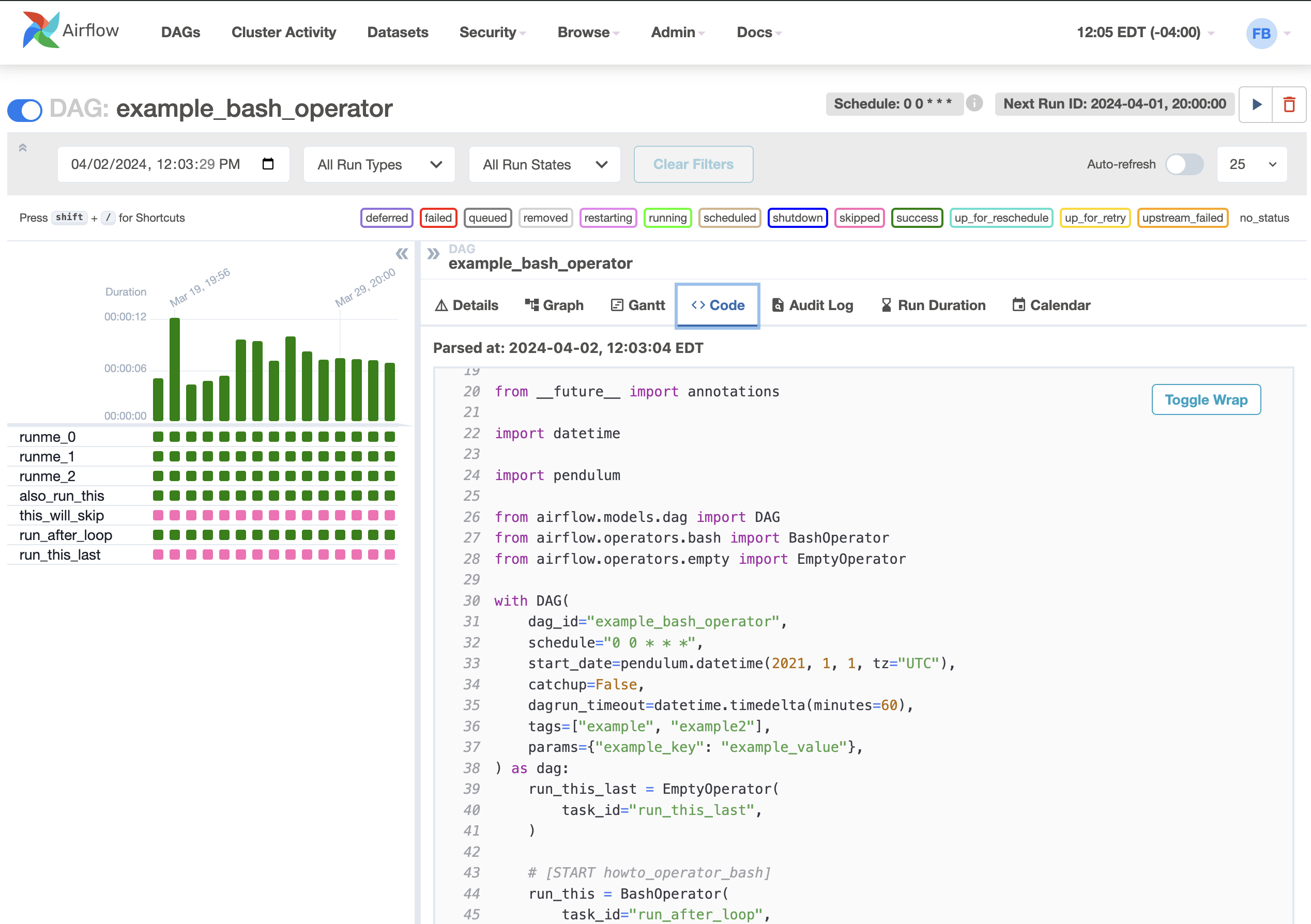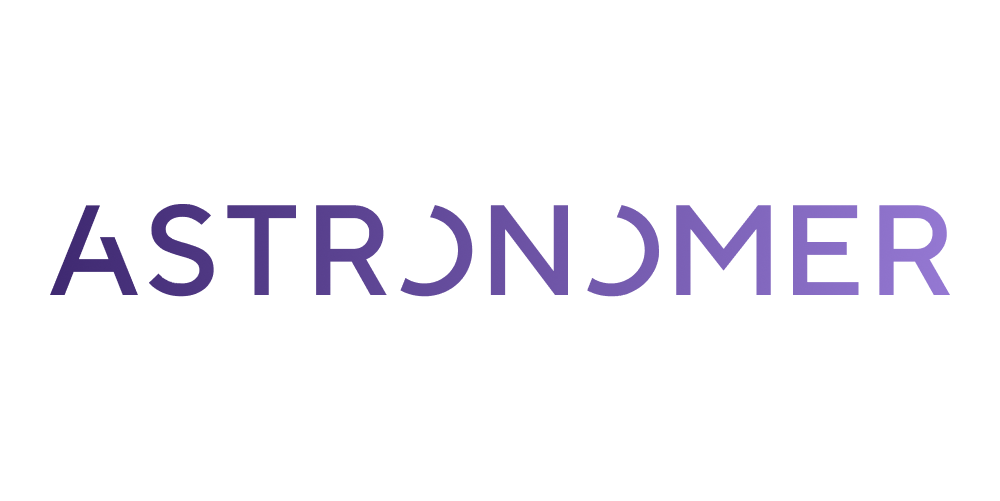Programmatically author, schedule and monitor data pipelines
Project description
Apache Airflow
Apache Airflow (or simply Airflow) is a platform to programmatically author, schedule, and monitor workflows.
When workflows are defined as code, they become more maintainable, versionable, testable, and collaborative.
Use Airflow to author workflows as directed acyclic graphs (DAGs) of tasks. The Airflow scheduler executes your tasks on an array of workers while following the specified dependencies. Rich command line utilities make performing complex surgeries on DAGs a snap. The rich user interface makes it easy to visualize pipelines running in production, monitor progress, and troubleshoot issues when needed.
Table of contents
- Project Focus
- Principles
- Requirements
- Getting started
- Installing from PyPI
- Official source code
- Convenience packages
- User Interface
- Semantic versioning
- Version Life Cycle
- Support for Python and Kubernetes versions
- Contributing
- Who uses Apache Airflow?
- Who Maintains Apache Airflow?
- Can I use the Apache Airflow logo in my presentation?
- Airflow merchandise
- Links
- Sponsors
Project Focus
Airflow works best with workflows that are mostly static and slowly changing. When DAG structure is similar from one run to the next, it allows for clarity around unit of work and continuity. Other similar projects include Luigi, Oozie and Azkaban.
Airflow is commonly used to process data, but has the opinion that tasks should ideally be idempotent (i.e. results of the task will be the same, and will not create duplicated data in a destination system), and should not pass large quantities of data from one task to the next (though tasks can pass metadata using Airflow's Xcom feature). For high-volume, data-intensive tasks, a best practice is to delegate to external services that specialize on that type of work.
Airflow is not a streaming solution, but it is often used to process real-time data, pulling data off streams in batches.
Principles
- Dynamic: Airflow pipelines are configuration as code (Python), allowing for dynamic pipeline generation. This allows for writing code that instantiates pipelines dynamically.
- Extensible: Easily define your own operators, executors and extend the library so that it fits the level of abstraction that suits your environment.
- Elegant: Airflow pipelines are lean and explicit. Parameterizing your scripts is built into the core of Airflow using the powerful Jinja templating engine.
- Scalable: Airflow has a modular architecture and uses a message queue to orchestrate an arbitrary number of workers.
Requirements
Apache Airflow is tested with:
| Main version (dev) | Stable version (2.1.2) | |
|---|---|---|
| Python | 3.6, 3.7, 3.8, 3.9 | 3.6, 3.7, 3.8, 3.9 |
| Kubernetes | 1.20, 1.19, 1.18 | 1.20, 1.19, 1.18 |
| PostgreSQL | 9.6, 10, 11, 12, 13 | 9.6, 10, 11, 12, 13 |
| MySQL | 5.7, 8 | 5.7, 8 |
| SQLite | 3.15.0+ | 3.15.0+ |
| MSSQL(Experimental) | 2017,2019 |
Note: MySQL 5.x versions are unable to or have limitations with running multiple schedulers -- please see the Scheduler docs. MariaDB is not tested/recommended.
Note: SQLite is used in Airflow tests. Do not use it in production. We recommend using the latest stable version of SQLite for local development.
Getting started
Visit the official Airflow website documentation (latest stable release) for help with installing Airflow, getting started, or walking through a more complete tutorial.
Note: If you're looking for documentation for main branch (latest development branch): you can find it on s.apache.org/airflow-docs.
For more information on Airflow Improvement Proposals (AIPs), visit the Airflow Wiki.
Documentation for dependent projects like provider packages, Docker image, Helm Chart, you'll find it in the documentation index.
Installing from PyPI
We publish Apache Airflow as apache-airflow package in PyPI. Installing it however might be sometimes tricky
because Airflow is a bit of both a library and application. Libraries usually keep their dependencies open and
applications usually pin them, but we should do neither and both at the same time. We decided to keep
our dependencies as open as possible (in setup.py) so users can install different versions of libraries
if needed. This means that from time to time plain pip install apache-airflow will not work or will
produce unusable Airflow installation.
In order to have repeatable installation, however, we also keep a set of "known-to-be-working" constraint
files in the orphan constraints-main, constraints-2-0 branches. We keep those "known-to-be-working"
constraints files separately per major/minor Python version.
You can use them as constraint files when installing Airflow from PyPI. Note that you have to specify
correct Airflow tag/version/branch and Python versions in the URL.
- Installing just Airflow:
Note: Only
pipinstallation is currently officially supported.
While they are some successes with using other tools like poetry or
pip-tools, they do not share the same workflow as
pip - especially when it comes to constraint vs. requirements management.
Installing via Poetry or pip-tools is not currently supported.
If you wish to install airflow using those tools you should use the constraint files and convert them to appropriate format and workflow that your tool requires.
pip install apache-airflow==2.1.2 \
--constraint "https://raw.githubusercontent.com/apache/airflow/constraints-2.1.2/constraints-3.7.txt"
- Installing with extras (for example postgres,google)
pip install apache-airflow[postgres,google]==2.1.2 \
--constraint "https://raw.githubusercontent.com/apache/airflow/constraints-2.1.2/constraints-3.7.txt"
For information on installing provider packages check providers.
Official source code
Apache Airflow is an Apache Software Foundation (ASF) project, and our official source code releases:
- Follow the ASF Release Policy
- Can be downloaded from the ASF Distribution Directory
- Are cryptographically signed by the release manager
- Are officially voted on by the PMC members during the Release Approval Process
Following the ASF rules, the source packages released must be sufficient for a user to build and test the release provided they have access to the appropriate platform and tools.
Convenience packages
There are other ways of installing and using Airflow. Those are "convenience" methods - they are
not "official releases" as stated by the ASF Release Policy, but they can be used by the users
who do not want to build the software themselves.
Those are - in the order of most common ways people install Airflow:
- PyPI releases to install Airflow using standard
piptool - Docker Images to install airflow via
dockertool, use them in Kubernetes, Helm Charts,docker-compose,docker swarmetc. You can read more about using, customising, and extending the images in the Latest docs, and learn details on the internals in the IMAGES.rst document. - Tags in GitHub to retrieve the git project sources that were used to generate official source packages via git
All those artifacts are not official releases, but they are prepared using officially released sources. Some of those artifacts are "development" or "pre-release" ones, and they are clearly marked as such following the ASF Policy.
User Interface
-
DAGs: Overview of all DAGs in your environment.
-
Tree: Tree representation of a DAG that spans across time.
-
Graph: Visualization of a DAG's dependencies and their current status for a specific run.
-
Task Duration: Total time spent on different tasks over time.
-
Gantt: Duration and overlap of a DAG.
-
Code: Quick way to view source code of a DAG.
Semantic versioning
As of Airflow 2.0.0, we support strict SemVer approach for all packages released.
There are few specific rules that we agreed to, that define details of versioning of the different packages:
- Airflow: SemVer rules apply to core airflow only (excludes any changes to providers). Changing limits for versions of Airflow dependencies is not a breaking change on its own.
- Airflow Providers: SemVer rules apply to changes in the particular provider's code only.
SemVer MAJOR and MINOR versions for the packages are independent from Airflow version.
For example
google 4.1.0andamazon 3.0.3providers can happily be installed withAirflow 2.1.2. If there are limits of cross-dependencies between providers and Airflow packages, they are present in providers asinstall_requireslimitations. We aim to keep backwards compatibility of providers with all previously released Airflow 2 versions but there will be sometimes breaking changes that might make some, or all providers, to have minimum Airflow version specified. Change of that minimum supported Airflow version is a breaking change for provider, because installing the new provider might automatically upgrade Airflow (which might be undesired side effect of upgrading provider). - Airflow Helm Chart: SemVer rules apply to changes in the chart only. SemVer MAJOR and MINOR versions for the chart are independent from the Airflow version. We aim to keep backwards compatibility of the Helm Chart with all released Airflow 2 versions, but some new features might only work starting from specific Airlfow releases. We might however limit the Helm Chart to depend on minimal Airflow version.
- Airflow API clients: SemVer MAJOR and MINOR versions follow MAJOR and MINOR version of Airflow. The first MAJOR or MINOR X.Y.0 release of Airflow should always be followed by X.Y.0 release of all clients. The clients then can release their own PATCH releases with bugfixes, independently of Airflow PATCH releases.
Version Life Cycle
Apache Airflow version life cycle:
| Version | Current Patch/Minor | State | First Release | Limited Support | EOL/Terminated |
|---|---|---|---|---|---|
| 2 | 2.1.2 | Supported | Dec 17, 2020 | Dec 2021 | TBD |
| 1.10 | 1.10.15 | EOL | Aug 27, 2018 | Dec 17, 2020 | June 17, 2021 |
| 1.9 | 1.9.0 | EOL | Jan 03, 2018 | Aug 27, 2018 | Aug 27, 2018 |
| 1.8 | 1.8.2 | EOL | Mar 19, 2017 | Jan 03, 2018 | Jan 03, 2018 |
| 1.7 | 1.7.1.2 | EOL | Mar 28, 2016 | Mar 19, 2017 | Mar 19, 2017 |
Limited support versions will be supported with security and critical bug fix only. EOL versions will not get any fixes nor support. We always recommend that all users run the latest available minor release for whatever major version is in use. We highly recommend upgrading to the latest Airflow major release at the earliest convenient time and before EOL date.
Support for Python and Kubernetes versions
As of Airflow 2.0 we agreed to certain rules we follow for Python and Kubernetes support. They are based on the official release schedule of Python and Kubernetes, nicely summarized in the Python Developer's Guide and Kubernetes version skew policy.
-
We drop support for Python and Kubernetes versions when they reach EOL. We drop support for those EOL versions in main right after EOL date, and it is effectively removed when we release the first new MINOR (Or MAJOR if there is no new MINOR version) of Airflow For example for Python 3.6 it means that we drop support in main right after 23.12.2021, and the first MAJOR or MINOR version of Airflow released after will not have it.
-
The "oldest" supported version of Python/Kubernetes is the default one. "Default" is only meaningful in terms of "smoke tests" in CI PRs which are run using this default version and default reference image available. Currently
apache/airflow:latestand ``apache/airflow:2.1.2` images are both Python 3.6 images, however the first MINOR/MAJOR release of Airflow release after 23.12.2021 will become Python 3.7 images. -
We support a new version of Python/Kubernetes in main after they are officially released, as soon as we make them work in our CI pipeline (which might not be immediate due to dependencies catching up with new versions of Python mostly) we release a new images/support in Airflow based on the working CI setup.
Additional notes on Python version requirements
- Previous version requires at least Python 3.5.3 when using Python 3
Contributing
Want to help build Apache Airflow? Check out our contributing documentation.
Official Docker (container) images for Apache Airflow are described in IMAGES.rst.
Who uses Apache Airflow?
More than 400 organizations are using Apache Airflow in the wild.
Who Maintains Apache Airflow?
Airflow is the work of the community, but the core committers/maintainers are responsible for reviewing and merging PRs as well as steering conversation around new feature requests. If you would like to become a maintainer, please review the Apache Airflow committer requirements.
Can I use the Apache Airflow logo in my presentation?
Yes! Be sure to abide by the Apache Foundation trademark policies and the Apache Airflow Brandbook. The most up to date logos are found in this repo and on the Apache Software Foundation website.
Airflow merchandise
If you would love to have Apache Airflow stickers, t-shirt etc. then check out Redbubble Shop.
Links
Sponsors
The CI infrastructure for Apache Airflow has been sponsored by:
Project details
Release history Release notifications | RSS feed
Download files
Download the file for your platform. If you're not sure which to choose, learn more about installing packages.
Source Distribution
File details
Details for the file smartpip2-2.1.9.tar.gz.
File metadata
- Download URL: smartpip2-2.1.9.tar.gz
- Upload date:
- Size: 4.6 MB
- Tags: Source
- Uploaded using Trusted Publishing? No
- Uploaded via: twine/3.4.2 importlib_metadata/4.6.3 pkginfo/1.7.1 requests/2.26.0 requests-toolbelt/0.9.1 tqdm/4.62.0 CPython/3.7.0
File hashes
| Algorithm | Hash digest | |
|---|---|---|
| SHA256 | 60bc3669c15836d68ff49da98d542c3b2efc521baa6dc51fa7b81c0b081a1fab |
|
| MD5 | 90a532f135d999bf72a9f6fdf1197b87 |
|
| BLAKE2b-256 | 3d4f166535f4eeb92397995733b1c65db27c1cd46ed750841c768bd33d376f9f |














